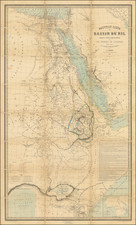Search
Giovanni Miani (1810–1872) was an Italian explorer whose work primarily focused on the exploration of the Nile and the region around the Uele River in present-day Democratic Republic of the Congo. Born on March 17, 1810, in Rovigo, Veneto, Italy, Miani embarked on a series of explorations that positioned him as a notable figure in the quest to identify the Nile's source.
Miani was born to Maddalena Miani, with his father's identity remaining unknown. His early education was sponsored by P. A. Bragadin, offering him a broad foundation in music, science, and languages. Following the death of his benefactor in 1828, Miani inherited a significant estate, which later financed his initial explorations. His mother's death in 1837 marked a turning point, leading Miani to devote his life to music and subsequently to exploration.
After fighting with Garibaldia during the Risorgimento, Miani fell out of favor and left Italy, moving to Istanbul, where he continued his career as a musician. After traveling in Egypt and Palestine, he learned Arabic and became interested in further exploration of the interior of Africa. In 1857 he visited Upper Nubia with two young Frenchmen, and drew a map of the region based on his own observations and the accounts of sailors, merchants, hunters and missionaries. He had the map printed in Paris in 1858 and presented a copy to Napoleon III, along with his project for exploring the Nile basin to find the river's source. He was admitted to the Société de Géographie of Paris.
Miani's notable expedition to the Nile began in 1859, supported by the Egyptian government and the Société de Géographie. On May 10, 1859, he departed Cairo, reaching Omdurman on July 20. Miani's journey took him to Sennar between September 20 and November 7, 1859, alongside a diverse team that included a navy captain and an Arabic-French translator.
On December 5, 1859, Miani advanced southward from Khartoum, engaging with Andrea Debono's company. Despite encountering resistance and hardships, he reached Gondokoro on January 24, 1860, a significant milestone in his journey. His attempt to navigate beyond the Makedo Falls was hindered by poor health and logistical challenges, forcing a return to Gondokoro.
Miani's exploration reached a critical point on March 29, 1860, when he ventured south, nearing the source of the Nile at a latitude of 3°32'N. Despite the proximity, hostile conditions and the refusal of his escort to proceed further compelled Miani to retreat.
Miani continued his explorations upon returning to Khartoum on May 22, 1860. His subsequent travels included ventures into the regions around the Uele River, marking him as one of the first Europeans to document this area.
Miani's third Nile expedition in 1871–1872 aimed to explore the Mangbetu region. Despite deteriorating health, he embarked on this journey, traversing challenging terrains and engaging with local tribes. His exploration provided detailed accounts of the regions and peoples encountered, contributing to the broader understanding of central African geography and cultures.
Miani's explorations, despite not achieving the goal of locating the Nile's source, added significant knowledge to the mapping and understanding of the Nile and central African regions. His detailed observations, maps, and collections of artifacts enriched European knowledge of Africa during a period of intense exploration interest.

